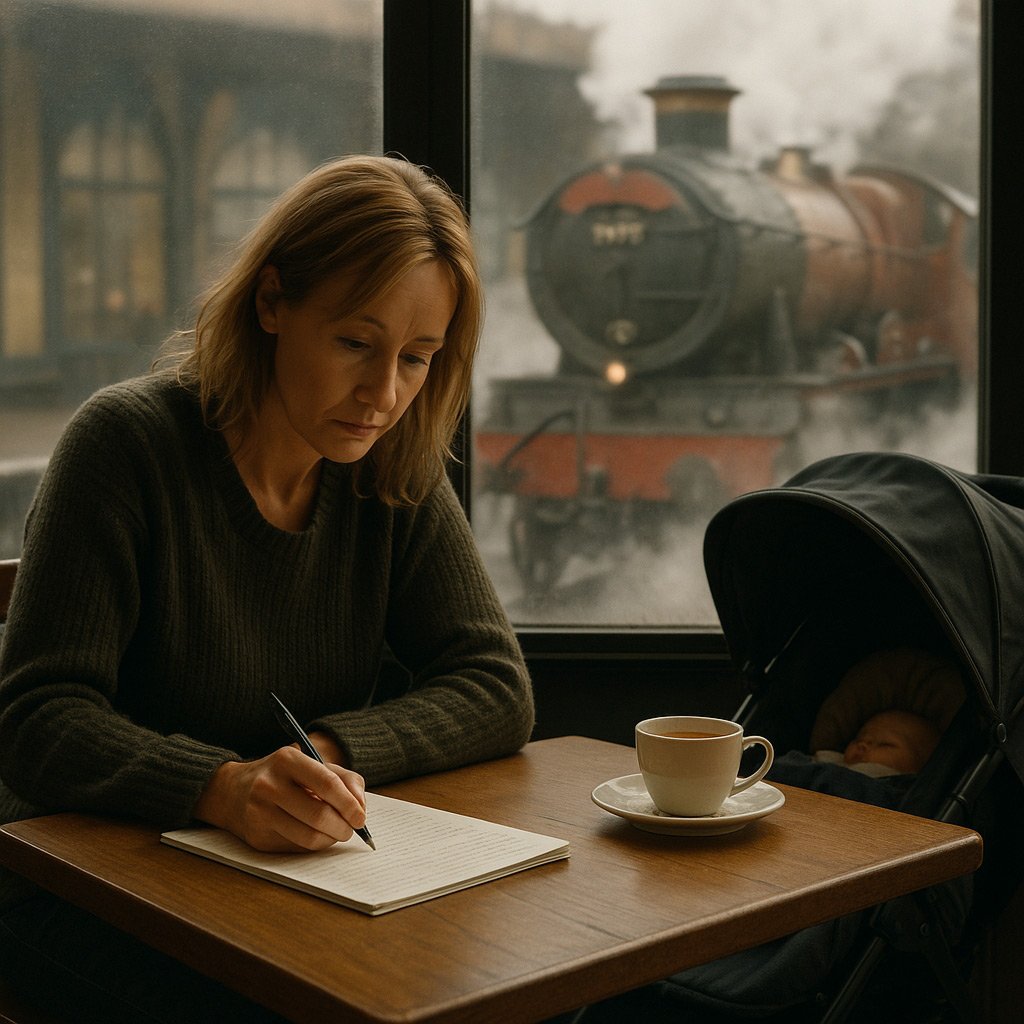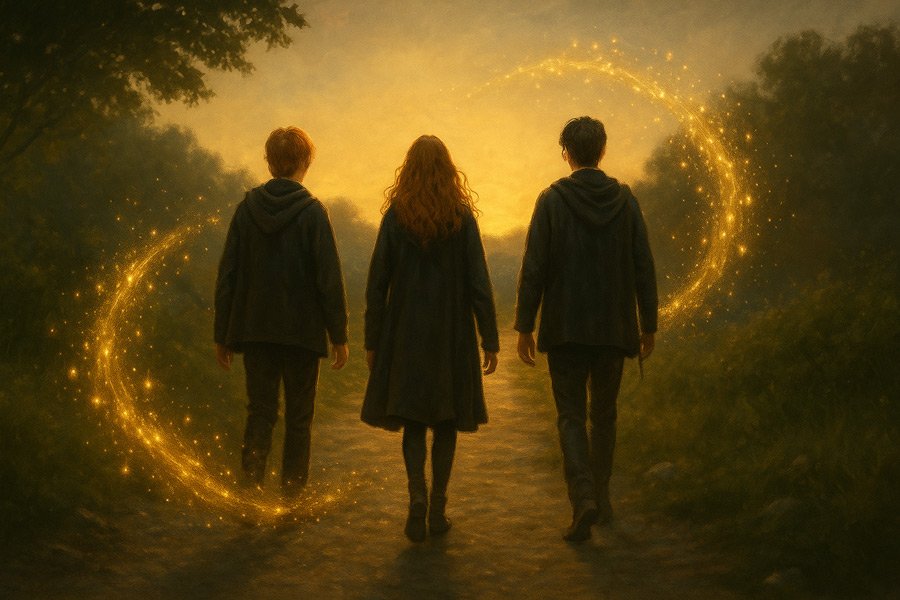Joanne Rowling’s journey to success was far from a fairytale.
Born to Peter and Anne on July 31, 1965, Joanne’s arrival wasn’t quite what they’d ordered — they’d wanted a boy. They even dressed her in blue to fit that idea.
With her father working as an aircraft engineer and her mother working as a science technician, her early life looked pretty comfortable to the outside world. They lived in a suburban house, with a little cupboard under the stairs.
But behind closed doors, Joanne relationship with her father was difficult; she was frightened by him, but also sought his approval. She had a better relationship with her mother, but her mum battled with multiple sclerosis — a diagnosis that cast a shadow over Rowling’s later work and life.
A Magical Train Ride
From an early age, she dreamed of becoming a writer. Around five or six, she was already creating characters, her first being a rabbit named — wait for it — Rabbit. Fast-forward to her twenties, and Rowling was in London, working as a bilingual secretary. At this point, she was far from the accomplished writer we know today.
But In 1990, during a four-hour delayed train ride from Manchester back to London, inspiration struck like a lightning bolt. She envisioned a boy who didn’t know he was a wizard, along with the Hogwarts school of Witchcraft and Wizardry, and the characters who would fill that world.
There was just one issue: she didn’t bring pen or paper on her train ride.
Nonetheless, Harry Potter and his world of magic came to life in her head.
From the very start, she envisioned Harry Potter as being more than just one book. She imagined the series as a seven-book arc, with key character developments already mapped out. She started writing, pouring her vision onto notes and scraps of paper, but fate had other plans. Tragedy struck: her mother passed away. Losing her was brutal and a long period of grief ensued.

Through the Forbidden Forest
Hoping for a fresh start, Joanne moved to Porto, Portugal, where she taught English by day and wrote in her spare time. Things seemed to be looking up when she met a Portuguese student in journalism named Jorge Arantes. Within a few months they were pregnant, but they were very quickly met with the tragic event of a miscarriage. They pulled through and eventually married, and they had a daughter, Jessica. The marriage, however, was tumultuous, with incidents of domestic abuse, eventually leading to Joanne filing for divorce.
With her 5-month old daughter in tow, she headed back to the UK and settled in Edinburgh, where her sister lived. Now a single mother, Rowling found herself at rock bottom, relying on welfare, often skipping meals so her daughter could eat. Depression moved in like a storm cloud that wouldn’t let up. Joanne later described it as follows:
“Depression is the most unpleasant thing I have ever experienced… It is that absence of being able to envisage that you will ever be cheerful again. The absence of hope. That very deadened feeling, which is so very different from feeling sad. Sad hurts but it’s a healthy feeling. It is a necessary thing to feel. Depression is very different.”
Yet, even in the grip of depression, she kept writing. Rowling didn’t just survive; she took those shadows and spun them into a story that would connect with millions.
A Phoenix Rises
Despite her hardships, Joanne completed the manuscript for Harry Potter and the Philosopher’s Stone in 1995. She sent the first three chapters to every publisher she could think of, only to face rejection after rejection. Eventually, one literary agent, Christopher Little, saw a glimmer of potential and asked to see the full manuscript. Rowling described this as “the best letter I had ever received in my life”—a crucial moment of validation after years of effort. Little understood Rowling’s vision and kept her motivated through additional rounds of publisher rejections.
It wasn’t until 1997, when her manuscript reached Bloomsbury Publishing, that Rowling finally got her break. The chief executive of Bloomsbury let his eight-year-old daughter, Alice Newton, read the first chapter. After an hour, she came downstairs and insisted on reading more. The appeal of Harry Potter to young readers was undeniable, and Newton issued Rowling a cheque for £2,500. Finally, 7 years after first conceiving of the world of wizardry on a train to London, the book was published in the U.K.
Even then, it was a modest start. Bloomsbury’s first print run was just 500 copies—many of them going straight to libraries. Yet shortly after publication, the book won its first award, the Nestlé Smarties Book Prize, an achievement that drew initial attention to Rowling’s work and increased public interest.
When the first book was set to published in the United States, a bidding war broke out, with Scholastic coming out on top with a $105,000 offer. This amount was life-changing for Rowling. She could finally focus on writing full-time, free from the day-to-day grind of survival.

A Global Spell
What started as a measly 500-copy print run exploded into one of the biggest literary phenomena of all time. The Harry Potter series shattered expectations, breaking through every age, culture, and language barrier to become a beloved global obsession. The books topped bestseller lists everywhere, selling over 500 million copies in more than 80 languages.
By the time each new release rolled around, it wasn’t just a book launch—it was an event. Midnight release parties, packed bookstores, and lines around the block. Fans of all ages came together to dive back into the world Rowling had built, and the mania was only growing.
With the immense popularity of the books, Hollywood couldn’t resist. And in 1999, Warner Bros. secured the film rights for the series, reportedly for $2 million. Rowling wasn’t about to let her story get twisted, though. She demanded creative control, ensuring that the films would stay true to the books’ themes, characters, and distinctly British identity. In 2001, Harry Potter and the Philosopher’s Stone hit theaters, kicking off a decade-long film franchise that brought the world of Hogwarts to life on the big screen. With Daniel Radcliffe, Emma Watson, and Rupert Grint in iconic roles and the whole thing helmed by visionary directors, the movies took Harry Potter to a whole new level of popularity. By the end, the eight films had raked in over $7 billion, cementing Harry Potter as one of the most successful franchises in cinematic history.
Rowling’s financial success paralleled the franchise’s growth. The books, the movies, the merchandise—it all added up. She became the world’s first billionaire author, and only one of seven female billionaires around the world.
Hope Beyond the Darkness
J.K. Rowling wove her setbacks and moments of darkness into the heart of Harry Potter. Her struggles with grief, rejection, and depression found their way onto the page.
Take the Dementors for example. These soulless beings that suck the life and joy out of anyone near them… they were born out of Rowling’s own battles with despair. For her, these hollow creatures were more than fantasy. They were the face of her darkest moments, a physical manifestation of that overwhelming emptiness.
Harry’s journey through rejection, loss, and grief isn’t the kind of stuff you usually find in kids’ books. A mother once wrote to Rowling, criticizing her for the dark themes in the books, and urging her to write a more “uplifting” and child-friendly ending. But for Rowling, these themes were too real to ignore. She gave Harry challenges that were raw and relatable, weaving in moments of vulnerability and resilience that resonate with anyone who’s faced hard times.
For those who have faced their own hardships, Harry Potter has become more than an escape; it’s a lifeline. Through Harry’s journey, Rowling showed that even in the bleakest moments, there’s strength in friendship, resilience in the face of fear, and the possibility of light after darkness. Her story reminds readers that setbacks don’t have to define you—instead, they can shape you, add depth to your story, and give you the empathy to connect with others.
Keep Swinging Your Wand!
From grinding it out through rejection to landing a deal that changed her life, Rowling’s journey is proof that sometimes, you just need to persevere and wait for that one person to believe in you. And once that door cracks open, you kick it down and let the world see what you’ve been working for.



